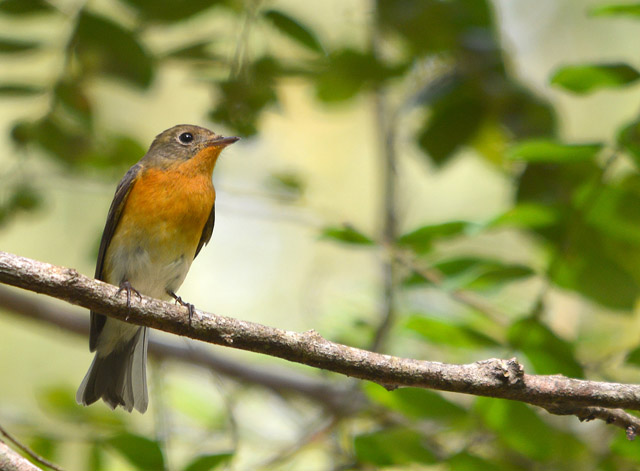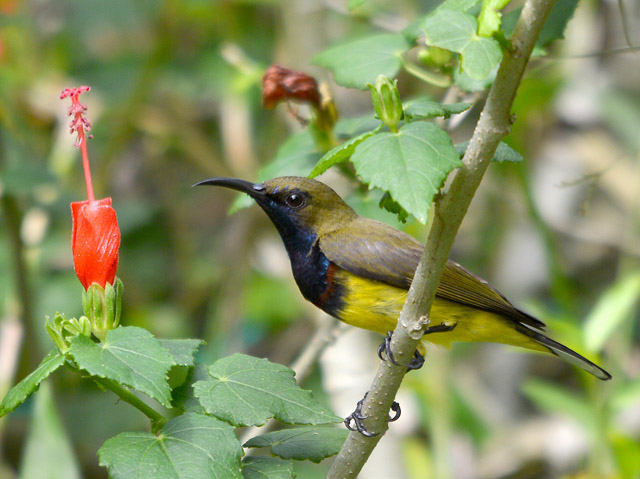The
male Mugimaki Flycatcher is an exquisite creature. Though not especially rare,
I could certainly do with some decent images of this stunning migrant. The
Penang Botanic Gardens is a known wintering site and when news reached my ears
of several individuals showing well at this popular recreational locality, there
was only one course of action to be taken. I had no trouble finding the exact
spot as there was a small crowd present upon my arrival. Penang Island is undeniably
small and the occurrence of not only Mugimaki Flycatchers but the rarer Zappey’s
Flycatcher as well will naturally draw in local birders and photographers like
bees to honey.
It
did not take long for the first Mugimaki Flycatcher to fly in from the adjacent
forest. Soon there were at least five individuals but unfortunately, all
females. Do forgive my lack of enthusiasm because the aesthetic appeal of the
females is a far cry from the males. And that is the brutal truth. The reason
for the congregation of these flycatchers is an active fruiting tree in the
landscaped garden. Some flycatchers, despite their name, are omnivorous. And a
fruiting tree can be as appealing as a swarm of insects.
As
I patiently waited for the arrival of the male Mugimaki Flycatcher, a
noticeably bigger flycatcher swooped in and it was the other current star bird
of this location. The Zappey’s Flycatcher is rarer than the Mugimaki Flycatcher
and this individual is an immature male. At the time of writing, the first record
(pending confirmation from the Records Committee) of a Blue-and-white
Flycatcher in Peninsular Malaysia was discovered in the state of Perlis. As
only the adult male is distinguishable from the commoner Zappey’s Flycatcher,
it is only right to leave the identification of this youngster that was also
gorging on the fruits of this faithful tree as a Zappey’s/Blue-and-white
Flycatcher.
An
immature “Blue-and-white Zappey” is uncommon enough to raise the level of
excitement for most who were present today. I thought to myself if only he was
a mature bird and out of nowhere, an adult male Zappey’s Flycatcher appeared to
the astonishment of everyone including yours truly.
I
usually keep myself calm and composed when in the presence of other birders. I
do have a reputation to maintain after all. But all that went out the window.
The rich blue plumage of this stunning bird took my breath away. This may not
be my first adult male Zappey’s Flycatcher but I do not think it is possible
for one to ever get enough of this bird. I enjoyed gripping views as he foraged
among the foliage. However, photography was challenging because he kept to the top
most parts of the tree.
Just
when I thought it could not get any better, he flitted down to the lower
branches and momentarily rested on an exposed perch. Call it luck, fate or even
divine intervention but it was just an incredible moment.
Soon
after, only the Mugimaki Flycatchers remained and as well as this confiding
Asian Brown Flycatcher. In the presence of more notable species, this common
migrant could not garner much attention despite being the most obliging
flycatcher in the vicinity.
It
is often difficult to age birds accurately. Even sexing can be complicated at
times. I consider it to be an art form and special set of skills are definitely
required. I, however, do not possess such skills and I like to keep my birding
simple. But it is not often one is surrounded by Mugimaki Flycatchers and I
took the opportunity to attempt this tedious task. These individuals with
brownish face and upperparts and lack any indications of a supercilium should
be females.
One
sported a deeper orange throat, more greyish face and upperparts and a faint
supercilium should be a first winter male.
I
may be going out on a limb here but I think this is also a young male...
Other
than the flycatchers, a number of other bird species were also attracted to the
fruits. Most did not provide good photographic opportunities. Either that or I
was too preoccupied with the flycatchers. The Yellow-vented Bulbuls were
present more or less throughout the duration of my visit.
Red-eyed
Bulbuls were given exceptional attention not because of their status or
anything like that. They forage rather cumbersomely much to the dislike of the
delicate flycatchers. This will often put the latter to flight and hinder our
photographic efforts.
Flocks
of Crested Mynas patrol the garden grounds as they have been doing for the past
decade or so. This species is the dominant myna here and from the look of
things, will continue to reign for years to come.
Along
the river bank, another regular species was going about its daily routine. In coastal
habitats, the Striated Heron is prevalent and can occur in huge numbers. It
also thrives in freshwater habitats but usually in smaller numbers.
As
I made my way back to my parked car, I stopped by a flowering bush that is usually
patronized by sunbirds. True enough, there was a pair of Olive-backed Sunbird.
I was utterly surprised not having to blame Murphy’s Law on this occasion
because the drabber female appeared to be more wary of my presence.
Her
handsome mate, on the other hand, fed without the slightest hesitance. The
subspecies that occurs here in the north sports an orangey collar which can be indistinct
at times. And the iridescent blue throat, despite being in good light, will only
reveal its true splendour in certain viewing angles.
The
Penang Botanic Gardens is one of the best sites to marvel at the radiance of
the male Crimson Sunbird. One was lingering about a bamboo clump but the
lighting condition was less than desirable. The vivid plumage colouration could
not be captured completely by a manmade device. Through my eyes though, he was remarkable
and certainly a worthy species to close chapter of my birding journal.
ps.
In case you wondering, the male Mugimaki Flycatcher managed to give me the slip
again – exactly like my last season’s attempt at the very same spot.
























No comments:
Post a Comment